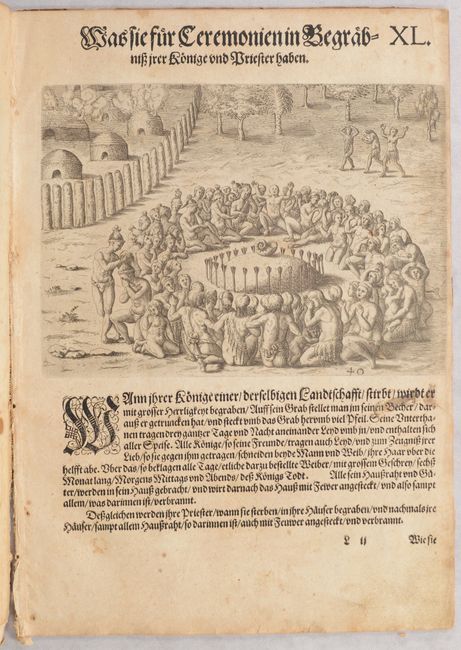Subject: Florida, Natives
Period: 1603 (published)
Publication:
Color: Black & White
Size:
9.1 x 13.4 inches
23.1 x 34 cm
This copper engraving is from a remarkable series of publications, illustrating voyages of discovery and travels of exploration to various parts of the world. The project was begun by Theodore de Bry of Frankfurt, in 1590 and was to continue for another 54 years. They became known collectively as the Grands Voyages (to America and the West Indies) and the Petits Voyages (to the Orient and the East Indies). De Bry died after the first six parts of the Grands Voyages were completed. The project was completed initially by his widow and two sons, Johann Theodore de Bry and Johann Israel de Bry, then by his son-in-law, Matthaus Merian in 1644.
This is a disbound chapter of the second German edition of Part II of De Bry's Grands Voyages, near complete but for the absence of the map Floridae Americae Provinciae Recens & Exactissima Descriptio... and Plate XXXIX. It includes 42 pages of German text, 2 titles pages, an index of plates, an armorial plate and dedication, an engraving of Noah's Ark, and 41 of the 42 classic plates on the Indigenous peoples of Florida. The plates are based on Le Moyne's famous drawings of the French colonial attempts in southeastern Florida in the 1560s. The additional engraving of Noah's ark precedes the text on Florida and seems to suggest a fantastical landing of the ark in the New World. Latin text below and blank versos with the exception of the plate of Noah and the ark, which has text on verso. The plates depict:
Noah's Ark
I) The Arrival of the French in Florida in 1562
II) The French Discover the River of May (St. Johns)
III) The French Discover Two Other Rivers
IV) They Discover Six More Rivers
V) The French Reach Port Royal
VI) The French Erect a Column with the Royal Coat of Arms
VII) Those Left Behind Run Short of Food
VIII) The Indians Worship the Column Erected by the French
IX) A Site for the Fort Is Chosen
X) Fort Caroline
XI) Satouriona Prepares for Battle
XII) Consulting a Sorcerer
XIII) The French Help Outina Fight the Patanou
XIV) How Outina's Army Marches to War
XV) How the Indians Treated the Corpses of Their Enemy
XVI) Indian Victory Ceremonies
XVII) The Duties of the Hermaphrodites
XVIII) How the Widows Petition Their Chief
XIX) How the Widows Lament at the Burial Grounds
XX) How the Indians Treat Their Sick
XXI) How the Indians Till the Soil
XXII) Collecting Crops for the Communal Storehouse
XXIII) Collecting Game for the Communal Storehouse
XXIV) How the Indians Preserved Game
XXV) How the Indians Hunt Deer
XXVI) Killing Alligators
XXVII) How the Floridians Go Swimming from Island to Island
XXVIII) Preparing for a Feast
XXIX) An Indian Council Meeting
XXX) A Fortified Indian Village
XXXI) Setting Fire to the Enemy’s Village
XXXII) How a Sentry Was Treated for Negligence
XXXIII) How the Indians Declare War
XXXIV) The Sacrifice of the First-Born Son
XXXV) A Harvest Offering
XXXVI) How the Young Men Were Trained
XXXVII) A Bride Is Carried to the Chief
XXXVIII) The Chief Receives His Bride
XL) How the Chief Is Buried
XLI) How the Indians Collect Gold from the Streams
XLII) The Murder of the Frenchman, Pierre Gambie
While the majority of this chapter is from the German edition of 1603, four plates are from the first German edition of 1591 (XIII, XXVI, XXXIIII, and XL). This example is still bound together without covers or a spine, except for a few plates that are loose (XXIV, XXV, and XXVI), however there is some variation in the paper sizes throughout, so this was likely compiled from several different examples of the second German edition.
References: Van Groesen (De Bry's America) pp. 92-145.
Condition: B
The plates range in condition from very good (B+) to good (B) with light to moderate toning and soiling. Several of the plates have been trimmed at right by the bookbinder with loss of a sliver of the image. Plate XXVI, which is detached, has heavier toning, a 4" tear at left that has been closed on verso with archival tape, and chipping along the edge of the sheet that extends into the image at bottom right. The title page has been trimmed at right by the bookbinder, with loss of a 2 mm sliver of image. The text has light to heavy toning and foxing. Page 42 has some old manuscript ink notations in the bottom margin.













